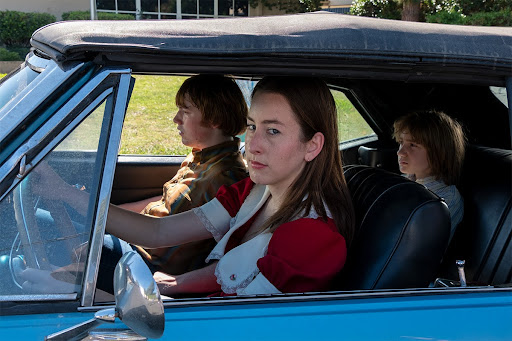Finally! Finally, some appreciation for the land in which I grew up. The San Fernando Valley is so often forgotten about, picked last in the schoolyard lineup when it comes to discussions about the great City of Angels (even though we were the first to get Chick-fil-A and have the best parking spots). It is a gratifying feeling to see a shining memory of my neighborhood in the ‘70s, delicately and lovingly reconstructed by cinematic master Paul Thomas Anderson. Anderson is no stranger to making movies set in the Valley with films like “Boogie Nights” (1997), “Magnolia” (1999) and “Punch-Drunk Love” (2002). However, what separates his latest film, “Licorice Pizza,” from the former is that the San Fernando Valley is more than just the backdrop; it becomes a living arena for the two main characters to find themselves and each other among the earthquake-worn sidewalks, swaying palm trees and dry heat.
The tennis-match love story of Gary Valentine (Cooper Hoffman) and Alana Kane (Alana Haim) shows the two going through the typical fluctuations of any movie romance: the flirtatious banter, the spiteful back-and-forths and the use of other romances as weapons and “blindfolds” to forget one another. The scales continuously tip for our characters, their power dynamic seesawing up and down. The main struggle comes from their sizable age gap: Gary is 15 and Alana is 25. While the two have tons of chemistry, Alana never makes things physical. Instead the two just hang out, maturing at different stages but nevertheless together, which is ultimately the focus of the film. “Licorice Pizza” is a hangout movie, echoing the same sentiments of films “Dazed and Confused” (1993) and “Fast Times at Ridgemont High” (1982). Gary and Alana navigate their tumultuous romantic tug-of-war through the streets of Ventura. Numerous unpredictable situations and even more unpredictable characters make up the narrative, strengthening the duo’s bond even when they initially seem like roadblocks to the relationship.
All the actors in minor roles give such staggering performances that it feels as though they are aware of their place in the fictional hierarchy and desperately want to be main characters. Bradley Cooper playing the grossly larger-than-life Jon Peters is a shining example. His stretch as the manic Hollywood hairdresser/mogul seems surreal until you read about the actual Jon Peters and realize that Cooper may have surprisingly underplayed him (emphasis on may). My favorite cameo was the messianic bard of vagrants, the king of the rain dogs, Tom Waits, whose raspy, black-lung voice kept a permanent smile on my face. Unlike his other, more subtle, performances in the works of Jim Jarmusch and the Coen brothers, there is nothing subtle about Waits here. Considering his character’s frenzied theatricality, I imagine Anderson wrote the character while listening to Waits’ album “Franks Wild Years,” specifically the track “I’ll Take New York.” Furthermore, Sean Penn (still hot), Benny Safdie (so excited for his next movie) and Skyler Gisondo (he went to my highschool, good for you Skyler) also make marked appearances. However, to my surprise, these big names couldn’t steal the spotlight from our two main characters.

Alana Kane (Alana Haim) driving with Gary Valentine (Cooper Hoffman). Courtesy of Focus Features.
“Licorice Pizza” marks the theatrical acting debuts of Hoffman and Haim. Hoffman has big shoes to fill considering his father, Philip Seymour Hoffman, was one of the greatest character actors to ever live and a mainstay cast member in Anderson’s previous work. I am relieved to say that acting runs in the family. Cooper’s performance is wholly his own. He tackles an archetype I don’t believe his father ever had the chance to play: the charming, confident high-school dreamer, aka that kid you want to be friends with. Take the conviction of Ferris Bueller without the self-awareness, combine it with the motivation of Max Fischer from “Rushmore” (1998) without the pretentiousness and you have Gary Valentine.
What was even more delightful to discover is that the initial focus on Gary is quickly stolen by Haim, who gives an incredible and naturalistic performance. Most of Anderson’s films focus on an eccentric unpredictable male character, but “Licorice Pizza” strays from that path, making Alana Kane truly the main attraction. The chemistry between Haim and Hoffman is unbelievable, further strengthened by their lack of experience on screen, which makes their acting feel more human. By the end of the film, I was convinced the two really were in love. Alana, of HAIM musical fame, is also accompanied by her actual family: the family of five recreate their Israeli-Jewish lifestyle on screen, and it feels effortless as a result. There’s something really charming about watching amateur actors nail their roles by playing their actual selves. The family dinner scene in particular feels as though Anderson uninvitedly brought his camera to document a real Haim family Shabbat dinner.
Teenage melodrama in movies is omnipresent, in love stories even more so, but there is a certain tenderness expressed and felt in “Licorice Pizza” that is so rare to find in a film. Some filmmakers get lucky and stumble upon this seemingly tangible sentimentality, the best are able to create it. As the credits rolled, that seldom-felt warmth washed over me, and it was clear that what I watched was no accident. It’s a shame this lovely cinematic experience was slightly marred by an obnoxious, highly liked, comment on YouTube I recently read: “Paul Thomas Anderson is the Stanley Kubrick of our generation.” It really annoys me that two greats have to be compared, one overshadowed, instead of admired separately. It is of my opinion that through a continuous output of great cinema, “Licorice Pizza” now an illustrious member of that lineup, Paul Thomas Anderson is the Paul Thomas Anderson of our generation.
The post Paul Thomas Anderson’s ‘Licorice Pizza’ affectionately shows the lesser known side of Los Angeles appeared first on The Emory Wheel.
